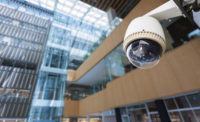This September will mark the 10th anniversary of 9/11 and some security pros fear that the worst could be yet to come. “Our view is that the goal of terrorists is to beat the devastation they caused on September 11, 2001, and one way to do that is to go after our children,” says Alan J. Robinson, director, Protection and Security Services/CSO, Atlantic Health, Morristown, NJ. “Topping the events of 9/11 is difficult to replicate; unfortunately, in order to exceed or even match the shock and awe of 9/11, terrorists must target a population so vulnerable it restores their reputation as a terrorist organization.”
For many, 9/11 caused a knee-jerk reaction to securing their facilities. “At the time of September 11, 2001, very few staff in public education knew what access control was and what it meant both in the short-term and the long-term for public education,” says Jeff Baker, director of safety and security for the Keller Independent School District in Keller, TX.
But, that has changed due to the growing importance of security-level requirements. According to a 2010 Avisian Physical Access Control Market Research Study, 79 percent of respondents desire the ability to proactively manage threats; 71 percent value programmable readers that simultaneously support multiple card technologies; and two-thirds of the respondents are interested in managing identification credentials. Two areas prone to attack on children – and proactively implementing access control systems – are hospitals and K-12 campuses.
Ditching the Lock and Key
Issues such as bullying, divorced parents and child abductions force school administrators to struggle with maintaining a balance between having a user-friendly, welcoming school climate and a facility that is secure from unwanted intruders. While even the best access control efforts will not guarantee that a determined outsider won’t gain access to the school, security directors are working with educators and administrators to take steps to reduce the risks of unauthorized access.
The Keller Independent School District has been taking those steps since 2000, upgrading security measures and installing access control systems at every campus and facility in the district. “Our biggest challenge was dealing with multiple locations, different building layouts, as well as a cultural change within our district and community regarding security” explains Baker. “While most of our facilities were built after 1995, a handful were constructed prior to the 1970s and were not designed with security in mind.”
Marcus DePontes, senior project coordinator, Protection and Security Services for Atlantic Health System, agrees: “Schools were originally built as community centers, open to the public, so they can be difficult to secure.”
“The challenge with access control in a K-12 environment is that the whole building needs to be secure during the school day as well as after hours,” says Errol Brudner, manager, Protection and Security Services, Atlantic Health System. “A critical component of an access control system is to alert school officials when a door is breached due to an unauthorized person entering or a child leaving without permission.”
Baker, who led the access control installation project team, utilizes proximity cards from HID Global. Every employee is given a unique identification code tied to the badge. The flexibility of the proximity card system allowed Baker to authorize access to single locations or multiple facilities if necessary. The system lets Baker and his team know who enters a building, at what time, and at what entry point location. They also know when someone tries to gain unauthorized access because the system automatically sends an email notification alarm. Access control card readers were placed at doors with the highest foot traffic points in their facilities.
“Once we installed the readers at exterior entry points, we were able to remove every key and lock in the district,” says Baker.
The Keller Independent School District – 38 campuses, 32,000 kids, and 4,000 employees – ultimately invested upwards of $5-$10 million in its access control system, which also includes 1,300 security cameras and Raptor Technologies’ web-based Raptorware. With Raptorware, a visitor’s driver license (or other state issued ID) is scanned and the software instantly screens for registered sex offenders. The system allows for additional entries regarding domestic dispute offenders and other security related issues. When a visitor is cleared, a badge featuring name, photo, date and time, and destination, is printed. If a potential threat is identified prior to a visitor gaining full access to a campus, the system instantly alerts designated officials via email, telephone, text message, or page.
Despite its capabilities, Baker has bigger plans for the access control system. “We aren’t using the access control system to its full ability just yet, but as we expand, it will be at a lower cost to the district because we have the necessary infrastructure in place,” says Baker. The district is looking at piloting a program at the middle and high school level that would assign one ID card for students, which would enable them to pay for school meals, check out library books, check out technology equipment, pay library fines and more. “Parents expect the schools to provide a safe and secure learning environment for their children and I believe we work towards this goal every day but much work remains as we try to prepare for possible future threats to our district,” he says. “We are very thankful to the taxpayers who voted to improve our security systems in KISD,” Baker says.
Stepping Up to the Plate
Achieving a sound physical access control program within a hospital environment requires a delicate balance of cost and security. “While the economy has hurt everyone, and budget cuts are common, healthcare facilities have put a premium on security measures and are stepping up to the plate, especially when there are antiquated or no systems in place,” says Jim Stankevich, CHPS, president of the International Association for Healthcare Security and Safety (IAHSS).
“In healthcare, it is easy to get frustrated as we have to get in line with other departments for capital funding,” says Robinson of Atlantic Health. Despite that challenge, hospitals are doing what is necessary to protect sensitive areas such as maternity wards and pediatric units.
Robert Ryan, CPP, CHPA, director of Security and Transportation at Children’s Hospital Boston, is up to speed on protecting the children who come to the hospital from all over the world. “When protecting children, we face issues such as divorced parents, restraining orders against family members and crowd control management as both immediate and extended family
is visiting.”
To get a handle on these challenges, Children’s installed a Lenel access control system, which monitors such devices as card readers, panic buttons and door systems, all tied to a Pelco Endura video management system to keep track of patients, visitors and employees. Additionally, an EasyLobby visitor management system produces a bar coded, self-expiring, temporary ID badge for parents/guardians and visitors. The bar code integrates with the Lenel access control system. When a parent/guardian or visitor enters, their picture is taken and they are granted a temporary 24-hour access to the building or floor where they need to go.
Eventually, Ryan would like to have the person’s name entered into a database to make sure that the person is not a registered sex offender or a possible threat to the patient.
“Having a good access control system is one of the most important components of any security program,” says Ryan. “Without it, we wouldn’t have a program.”
Lauris Freidenfelds, director, Security Services Emergency Management, Rush University Medical Center in Chicago, says access control is essential to protecting the dozen or so security sensitive areas at the hospital. His program consists of a staff and visitor management system that relies on the Tyco International C-Cure 9000 Access Control System and American Dynamics CCTV for application in a multi-layered approach. “Having the alarm data and the visual element to back it up was enticing to us when we were searching for an access control system,” he says.
In addition, Rush identification cards are color-coded to ensure that only those with access to certain areas remain in those areas. Patients are made aware of the color system so that they can rest assured that only authorized personnel are permitted near them. “This is especially important in labor and delivery where the safety of the babies is of utmost importance,” says Freidenfelds.
Rush University uses biometrics (fingerprint readers) as another level of access control for security-sensitive areas.
Protecting security-sensitive areas is also critical at Atlantic Health System Hospitals, says Robinson. Located in New Jersey, the hospital considers itself in a high-risk region for terrorism and made the move about seven years ago to tighten security in those sensitive areas.
Robinson credits the C-Cure Access Control System and Intellix security cameras with that task. “We have 10,000 people coming through our doors everyday and we make sure that we know every one of them,” he says. “When people know that we rely on identification badges to restrict access, it is definitely a deterrent.”
Whether they are on a K-12 campus or in the pediatric ward of a hospital, security directors are keeping their team’s feet to the fire when it comes to protecting children. “We will never be in a pre-9/11 world again, so those of us whose job it is to protect children must be constant and vigilant in doing so,” says Robinson.





